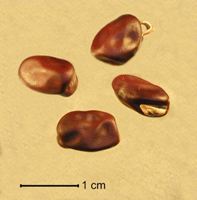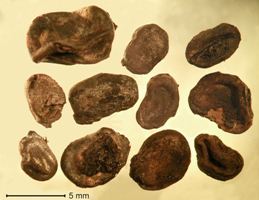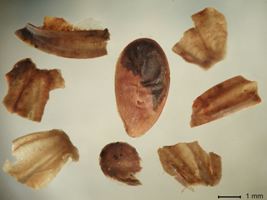

Figure 48: Modern Celtic beans (Vicia faba var. minor). Photo BIAX Consult.
Figure 49: Mineralised Celtic beans (Vicia faba var. minor) found in one of the Roman rural settlements in the coastal area of the Netherlands. Photo BIAX Consult.
Although pulses were important providers of protein, we usually find little evidence for them, since they are not preserved well. Celtic bean (Vicia faba var. minor) was found once in Tiel-Passewaaij and also occurs in Geldermalsen-Hondsgemet and Kesteren-De Woerd (Figs. 48 and 49). In contrast to cereals, it is almost impossible to establish whether Celtic beans were cultivated. A good indication would be the remains of pods, but these are seldom found in archaeological contexts. The presence of Celtic bean in many agrarian sites makes local production likely. It is an easily cultivated crop that is sown in early spring and can be ready to harvest in early summer. Pulses can be grown on a large scale, but if they are only used for local consumption, they can also be grown in vegetable gardens.


Figure 48: Modern Celtic beans (Vicia faba var. minor). Photo BIAX Consult.
Figure 49: Mineralised Celtic beans (Vicia faba var. minor) found in one of the Roman rural settlements in the coastal area of the Netherlands. Photo BIAX Consult.
Vegetable gardens generally contain those products that are cultivated at a small scale, need relatively high care, can be harvested over an extended period of time, and usually need a relatively large amount of manure. These factors probably played a role in the past. Celtic beans, however, do not need more manure than cereals and could therefore be grown in arable fields located outside the settlement. Although the Roman army diet also contained pulses, Celtic bean is not found in any of the Middle Roman forts. That could mean that in Tiel-Passewaaij, Celtic bean was grown for local consumption in vegetable gardens.
Flax (Linum usitatissimum) is another crop of uncertain status in agrarian settlements in the Dutch River Area (Fig. 50). Like Celtic bean, it is found in small numbers in many agrarian settlements, including Tiel-Passewaaij. The presence of fragments of the capsules enclosing the seeds suggests that the crop was cultivated in Tiel-Passewaaij. Flax is only found in low numbers in agrarian settlements in the Dutch River Area; it is therefore uncertain whether the crop was also grown as a surplus for the market. Flax is a crop with two uses: it can be grown for its seeds from which oil can be sourced, or it can be grown for the fibres in its stems from which linen is made. Flax is a summer crop. It can be grown on well-drained loam, sandy loam or light clay and needs a reasonable amount of manure. Considering these conditions, it is assumed that flax in Tiel-Passewaaij was grown on the higher parts of the streamridge. The necessity for manure makes it likely that the flax fields were located close to the settlement.

Figure 50: Waterlogged flax (Linum usitatissimum) seed and fragments of capsules. Photo BIAX Consult.
Several other oil crops were cultivated in the Dutch River Area, including black mustard (Brassica nigra), rape (Brassica rapa), gold-of-pleasure (Camelina sativa) and opium poppy (Papaver somniferum). Of these crops, only rape was found in Tiel-Passewaaij. In Geldermalsen-Hondsgemet, gold-of-pleasure and opium poppy were present as well as rape. In Kesteren-De Woerd, gold-of-pleasure was the only one of these crops found, apart from flax. Houten-Tiellandt is the only settlement so far where all the oil crops occurred.
The rape found in Tiel-Passewaaij, Geldermalsen-Hondsgemet and Houten-Tiellandt could also have been grown as a vegetable. In that case, the crop has a longer harvest period and is more likely to have been grown in vegetable gardens.
© Internet Archaeology/Author(s)
URL: http://intarch.ac.uk/journal/issue27/5/3.4.2.html
Last updated: Tue Nov 10 2009